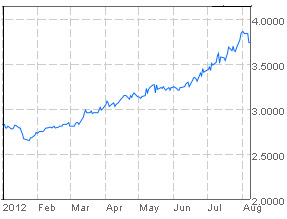
This article was recently published on Calvin Yeo's blog, www.investinpassiveincome.com, and is reproduced with permission.
RECENTLY, ONE OF my readers asked me this question based on an article he read in The Straits Times: How viable is it to deploy leverage on dividend investing?
The article is rather long but here are its main points.
Article Snapshot
A Leveraged Dividend Investment strategy is one such opportunity that can be implemented currently.
In a nutshell, it works by enabling an investor to build a portfolio of dividend paying stocks that will still yield a net positive dividend return even after the cost of financing the portfolio is taken into account.
To this end, OCBC Securities’ newly launched Quality Priced Loan (QPL) feature for its Share Margin Financing account helps the investor do just that.
Its key feature is that the cost of financing charged is inversely related to the quality of the stock purchased.
Such a strategy can be illustrated by a single dividend paying stock portfolio.
Let’s assume that an investor would like to purchase Starhub shares at $3.49 using 70% financing. This means that for a $100,000 portfolio comprising Starhub shares, the investor would need to invest $30,000 and borrow the remaining $70,000 on margin.
At an entry price of $3.49, Starhub’s projected yield for 2012 is approximately 5.7%.
Hence, if the portfolio were held for a year, the accumulated cash dividends received would amount to $5,700.
On the borrowing side, the cost to borrow $70,000 for a year would amount to $2,450 (assuming a rate of 3.5% is charged).
The net cash return would thus amount to $3,250 (the difference between the dividends earned and the financing costs paid).

On a returns basis, this works out to an extremely rewarding return of 10.8% on the $30,000 initially invested, not an insignificant return in today’s low interest rate environment.
This strategy, though, is not without risks.
The investor still has to contend with the overall market volatility and the price fluctuation of his chosen dividend paying stock(s).
However, this risk and uncertainty can be mitigated through his stock selection process. Appropriate screening and due diligence of the universe of dividend paying stocks can be undertaken to identify fundamentally strong firms.
A suitable portfolio of dividend paying stocks can then be chosen to match the investor’s risk profile.
My Comments
Leverage for dividend stocks or margin financing is a viable strategy. Do take note of a few things though.
1. Not all stocks are leverageable, LTV ratio depends on the quality of the stock, i.e. blue chips can get higher margin, penny stocks low margin or no margin
2. The interest rate of 3.5%-4% on the loan is higher than normal SIBOR+spread ranges. It may make sense to use a cheaper form of financing, such as mortgage financing if available.
3. Your dividend yield should be at least 2% higher than the interest, so at least 6% in this case.
4. It is prudent to use leverage only up to 20-30% for stocks due to the volatile nature of the stock prices. If your margin is too high, like above 70%, it is quite possible to get hit with a margin call if the stock pries fall, even if you intend to hold the stock for long term.
5. Self discipline is very important as leverage can magnify your gains as well as losses. It is not recommended for beginner to novice investors.
6. OCBC is not the only bank offering this services, in fact many brokerages offer it in the form of margin financing. The interest rates also vary from bank to bank and based on customer status as well. For example, a private banking client may get a higher LTV and lower interest rates than a standard retail customer.
7. Margin financing on stocks is NOT THE SAME AS CFDs. While they both offer leverage, they are very different animals. See Understanding Contract For Difference (CFD) In The Wake of MF Global bankruptcy.
Recent story: CALVIN YEO: "IHH's IPO has rich valuations, no clear dividend policy"


